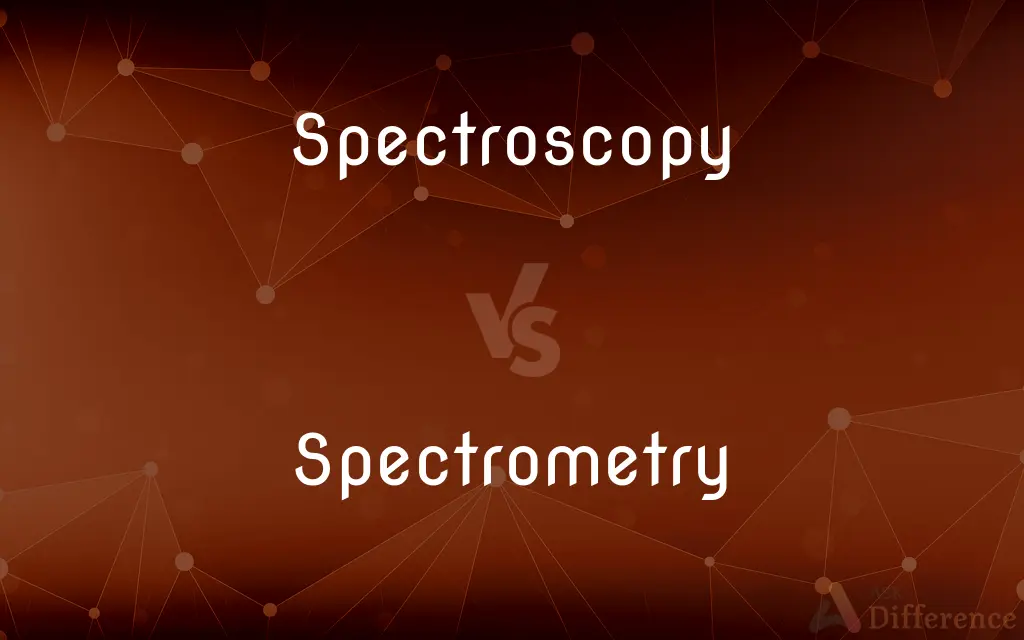Spectroscopy vs. Spectrometry — What's the Difference?
Edited by Tayyaba Rehman — By Fiza Rafique — Updated on March 13, 2024
Spectroscopy studies the interaction between matter and electromagnetic radiation, while spectrometry measures the properties of light to identify substances.

Difference Between Spectroscopy and Spectrometry
Table of Contents
ADVERTISEMENT
Key Differences
Spectroscopy is the scientific study of the interaction between matter and electromagnetic radiation, focusing on how light interacts with atoms and molecules to produce distinctive spectra. This interaction can reveal a wealth of information about the substance's structure, composition, and physical properties. On the other hand, spectrometry involves the measurement of these spectra, specifically the intensity of light as a function of wavelength or mass, to quantitatively analyze the concentration and composition of a substance.
Spectroscopy is often used qualitatively to understand the types of bonds, electronic transitions, or molecular vibrations within a sample, based on the absorption, emission, or scattering of light. Spectrometry, however, takes this a step further by quantifying these interactions to determine precise concentrations of elements or compounds within a sample. It relies on instruments like spectrometers or spectrographs to capture and measure the spectral data.
While the terms spectroscopy and spectrometry are frequently used interchangeably in practice, their focus differs. Spectroscopy is more about the theoretical and experimental aspects of studying light-matter interactions, whereas spectrometry is concerned with the practical application of measuring these interactions to achieve analytical objectives.
In applications, spectroscopy serves as the foundation for techniques such as infrared spectroscopy, UV-visible spectroscopy, and nuclear magnetic resonance (NMR) spectroscopy, each suited to specific types of analysis based on the energy levels involved. Spectrometry, through devices like mass spectrometers and UV-visible spectrometers, enables the identification and quantification of substances in various fields, from environmental analysis to medical diagnostics and forensic science.
The development of spectroscopic methods has significantly enhanced our understanding of the atomic and molecular levels of matter, providing insights into chemical bonding, reaction dynamics, and material properties. Spectrometry, with its ability to deliver precise and quantitative analysis, plays a crucial role in the practical application of these insights across scientific research, quality control, and diagnostic processes.
ADVERTISEMENT
Comparison Chart
Definition
The study of the interaction between matter and electromagnetic radiation.
The measurement of light's properties to identify and quantify substances.
Focus
Qualitative analysis of light-matter interactions.
Quantitative measurement of spectra.
Applications
Identifying chemical bonds, molecular vibrations, electronic transitions.
Determining the concentration and composition of substances.
Techniques
Infrared, UV-visible, NMR spectroscopy.
Mass spectrometry, UV-visible spectrometry.
Instruments
Spectroscopes for observing spectra.
Spectrometers for measuring spectral data.
Outcome
Insights into structure, composition, physical properties.
Precise quantitative analysis of elements or compounds.
Compare with Definitions
Spectroscopy
Analyzing substances based on their emitted or absorbed light.
Infrared spectroscopy identifies molecular vibrations in organic compounds.
Spectrometry
Measuring light to identify and quantify substances.
Mass spectrometry quantifies pesticides in water samples by measuring mass-to-charge ratios.
Spectroscopy
Essential for understanding chemical and physical properties.
NMR spectroscopy provides insights into molecular structure by observing nuclear spin transitions.
Spectrometry
Key for precise analytical and diagnostic processes.
Inductively coupled plasma mass spectrometry identifies trace elements in biological materials.
Spectroscopy
The study of how light interacts with matter.
Using UV-visible spectroscopy to examine the electronic transitions in a molecule.
Spectrometry
Applied in environmental analysis, forensics, and health.
Atomic absorption spectrometry measures metal concentrations in environmental samples.
Spectroscopy
A tool for qualitative analysis in chemistry and physics.
Raman spectroscopy differentiates between molecular structures through scattered light.
Spectrometry
Involves capturing spectral data for quantitative analysis.
UV-visible spectrometry determines the concentration of a solution by its light absorption.
Spectroscopy
Used to investigate atomic and molecular energy levels.
Fluorescence spectroscopy detects compounds based on their light emission after excitation.
Spectrometry
Utilizes instruments to analyze spectra for composition.
Gas chromatography-mass spectrometry separates and identifies volatile compounds in a mixture.
Spectroscopy
Spectroscopy is the study of the interaction between matter and electromagnetic radiation as a function of the wavelength or frequency of the radiation. In simpler terms, spectroscopy is the precise study of color as generalized from visible light to all bands of the electromagnetic spectrum; indeed, historically, spectroscopy originated as the study of the wavelength dependence of the absorption by gas phase matter of visible light dispersed by a prism.
Spectrometry
A spectroscope equipped with scales for measuring wavelengths or indexes of refraction.
Spectroscopy
The study of spectra, especially experimental observation of optical spectra or mass spectra, to determine the properties of their source.
Spectrometry
The measurement of the wavelength of electromagnetic radiation, especially any of several techniques used to analyze the structure of molecules; the measurement of spectra of things other than radiation, such as the masses of molecules and their breakdown products
Spectroscopy
A variety or instance of such study.
Spectrometry
Art or process of using a spectrometer, of any type; - when used alone, it usually refers to the use of a spectrometer using light in the visible, infrared, or ultraviolet region.
Spectroscopy
(uncountable) The scientific study of spectra.
Spectrometry
The use of spectroscopes to analyze spectra
Spectroscopy
The use of spectrometers in chemical analysis.
Spectroscopy
The art and science dealing with the use of a spectroscope, and the production and analysis of spectra; the action of using a spectroscope.
Spectroscopy
The use of spectroscopes to analyze spectra
Common Curiosities
What is spectrometry?
Spectrometry is the quantitative measurement of a substance's spectrum, typically to identify and quantify its components.
Is spectrometry used for qualitative or quantitative analysis?
Spectrometry is primarily used for quantitative analysis, measuring the intensity of light across different wavelengths to determine substance concentrations.
How do spectroscopy and spectrometry differ?
Spectroscopy focuses on qualitative analysis of light-matter interactions, while spectrometry quantifies these interactions to analyze substance composition.
Can spectroscopy identify substances?
Yes, spectroscopy can identify substances based on their unique spectral signatures but is more focused on understanding their properties.
Which is more suitable for determining the concentration of a solution, spectroscopy or spectrometry?
Spectrometry, because it quantitatively measures the spectrum to precisely determine concentrations.
What instruments are used in spectroscopy?
Instruments like spectroscopes are used in spectroscopy to observe the interaction between light and matter.
What is spectroscopy?
Spectroscopy is the study of how matter interacts with electromagnetic radiation to understand its composition, structure, and properties.
Can both techniques be used in environmental analysis?
Yes, both are used in environmental analysis, but spectrometry is more often applied for quantifying pollutants or contaminants.
How have these techniques impacted scientific research?
They have revolutionized our understanding of molecular and atomic structures, enabling precise analysis in fields ranging from chemistry to medicine and environmental science.
What instruments are used in spectrometry?
Spectrometers, which measure and record the spectrum of a sample, are used in spectrometry for quantitative analysis.
Share Your Discovery

Previous Comparison
Split vs. Tear
Next Comparison
Lucid vs. PellucidAuthor Spotlight
Written by
Fiza RafiqueFiza Rafique is a skilled content writer at AskDifference.com, where she meticulously refines and enhances written pieces. Drawing from her vast editorial expertise, Fiza ensures clarity, accuracy, and precision in every article. Passionate about language, she continually seeks to elevate the quality of content for readers worldwide.
Edited by
Tayyaba RehmanTayyaba Rehman is a distinguished writer, currently serving as a primary contributor to askdifference.com. As a researcher in semantics and etymology, Tayyaba's passion for the complexity of languages and their distinctions has found a perfect home on the platform. Tayyaba delves into the intricacies of language, distinguishing between commonly confused words and phrases, thereby providing clarity for readers worldwide.














































